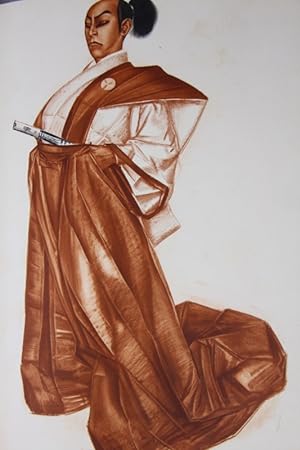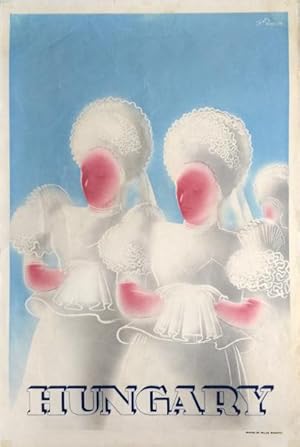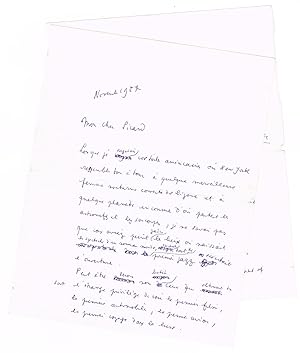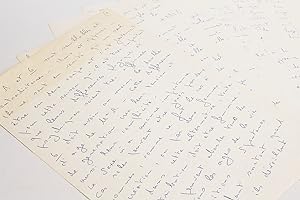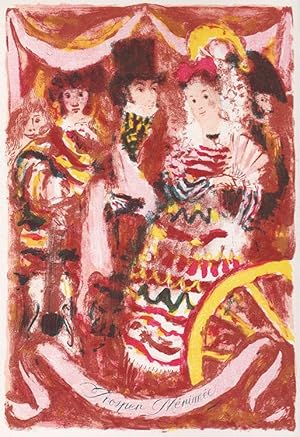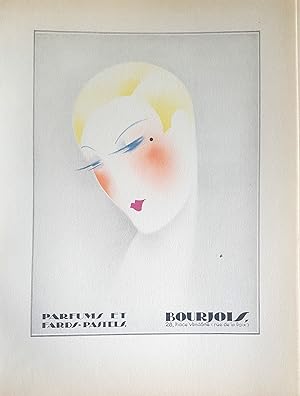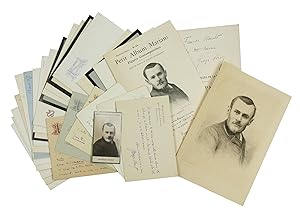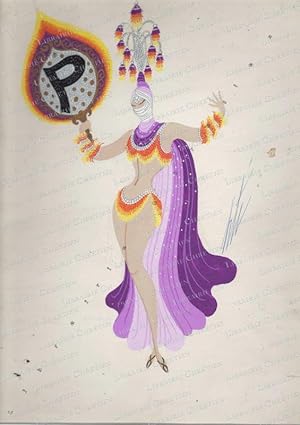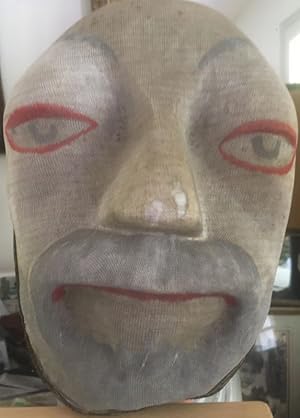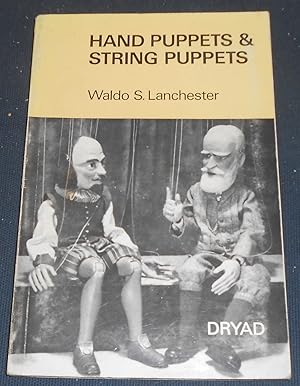art spectacle (Plus de 4 900 résultats)
Type d'article
- Tous les types d'articles
- Livres (4 591)
- Magazines & Périodiques (153)
- Bandes dessinées
- Partitions de musique
- Art, Affiches et Gravures (114)
- Photographies (35)
- Cartes (1)
-
Manuscrits &
Papiers anciens (11)
Etat
Reliure
Particularités
- Edition originale (463)
- Signé (103)
- Jaquette (385)
- Avec images (3 572)
- Sans impression à la demande (4 880)
Livraison gratuite
Pays
Evaluation du vendeur
-
La Loïe Fuller. Estampes modelées de Pierre Roche
Edité par Charles Hérissey [pour les Cent Bibliophiles], Évreux, 1904
In-4 de 26 pp., les deux dernières non chiffrées, en feuilles, sous couverture rempliée et illustrée en couleurs ; étui de l?éditeur en papier japon ivoire portant, sur le premier plat, le titre ; cordons de soie jaune Édition originale : tirage unique à cent trente exemplaires sur papier vélin fort, celui-ci, nº 97, pour Georges Teyssier. Edité pour la société des Cent Bibliophiles, le livre marque la première application du caractère italique dessiné par Georges Auriol, gravé et fondu par G. Peignot et fils. Le livre est imprimé selon la méthode chinoise, c?est-à-dire sur un seul côté de feuillets doubles collés ensuite entre eux, afin d?éviter que l?empreinte des gravures n?apparaisse sur la page suivante. L?ouvrage est un hommage à la Loïe Fuller (1862-1928), cette danseuse d?origine américaine dont les spectacles ont fasciné la génération symboliste : elle utilisait de longs voiles transparents qu?elle faisait tournoyer et un savant jeu de lumières, créant ainsi des spectacles féeriques. On se pressait à ses représentations,qui connurent une vogue inouïe : Mallarmé, qui voyait dans la danse ?la forme théâtrale de poésie par excellence?, Rodenbach, qui lui consacra un poème, Jean Lorrain ou Auguste Rodin comptaient au nombre des spectateurs enthousiastes.On y croisait aussi les Curie, Georges Méliès ou les frères Lumière, ainsi que la plupart des artistes, poètes ou écrivains de l?époque. La fluidité et le mouvement très particuliers de ses chorégraphies sont rendus ici par les illustrations gravées en couleurs de Pierre Roche. L?illustration comprend 18 compositions gravées en relief et coloriées, dont une à pleine page et deux planches pour les plats de la couverture. Les gravures sont des gypsotypies : cette technique a été inventée et mise au point par un sculpteur, élève de Rodin, Fernand Massignon dit Pierre Roche (1855-1922). ?Pierre Roche était un sculpteur qui se fit graveur. Séduit par l?aspect nacré et résistant des papiers japonais qui arrivaient alors en Europe, il voulut jouer de leur lumière et inventa l?estampe modelée et nuancée. Dès 1892, il moula sur creux de plâtre des estampes qu?il coloriait ensuite au pinceau : ce qu?il appela des aquarelles estampées.Puis il eut l?idée de considérer la matrice de plâtre comme une gravure sur bois où étaient portés différemment l?encre et la couleur et où le papier humide comprimé à la main prenait à la fois teinte et modelé : ce fut la gypsographie. La fragilité du plâtre ne permettait que des petits tirages, aussi le remplaça-t-il par du métal, qui donnait plus de raideur. C?est par ce dernier procédé, la gypsotypie, qu?il appliqua pour la première fois en 1904,sa technique à un livre, La Loïe Fuller de Roger Marx, où les estampes telles des médailles, s?intégraient à la typographie du texte? (A. Coron, Des livres rares depuis l?invention de l?imprimerie, Paris, BnF, 1998, p. 284).Précieux exemplaire complet du rare étui décoré de l?éditeur.Un des cordonnets de soie jaune n?a pas été conservé ; l?autre est abîmé. L?exemplaire est préservé dans une boîte décorée exécutée par Antonio.(Ray, The Art of the French illustrated Book, 1700-1914, nº 358 : ?This little-known volume is like nothing elseof its time.?- Books illustrated by Painters and Sculptors from 1900, The Arts Club of Chicago, 1980, nº 52).
-
. Illustrateur : BRUNELLESCHI (Umberto). (illustrateur). 22 aquarelles pour le spectacle-opérette de Mogador, sur papier cartonné beige, 21 signées en bas à droite, 4 datées (1938), rehauts d'or et de blanc, mine de plomb, feuilles de 32 x 25 environ, dessins de 30 x 15 cm. environ. Umberto BRUNELLESCHI (Toscane-Italie-1849-1949 Paris), peintre, portraitiste, illustrateur, artisre de la mode, publicitaire, affichiste, décorateur italien. Influencé par la Comedia dell'Arte, mais également les créations de la troupe de DIAGHILEV, il crée des costumes pour les Folies Bergère, le Casino de Paris, le théâtre du Châtelet, des théâtres new-yorkais, italiens et allemands. Il commence sa carrière de costumier en 1914, avec une revue de scène aux "Bouffes parisiennes", montée par Madame RASIMI pour laquelle il crée des costumes sur les masques vénitiens. Il travaille ensuite à Florence au théâtre de la Pergola pour deux pièces (1915), puis, toujours pendant la guerre, à la Scala de Milan. A son retour à Paris, il travaille pour le music-hall : les années 1925-1938 sont celles de ses plus grands succès. Sa renommée est telle qu'en 1924, Giacomo PUCCINI lui écrit après avoir composé "Turandot" : "Cher Brunelleschi, Turandot est quasiment terminé. Je pense à vous pour les figures". L'opéra, qui se donne à la Scala en 1925, est un succès. En 1928, il travaille à New-York, sur l'invitation du danseur Léonide MASSINE. Son style se modifie et devient plus structuré et graphique : il met au point sa fameuse silhouette oblongue. Ses motifs décoratifs s'attachent à de nouvelles sources, notamment grâce à la danseuse Joséphine BAKER dans l'opérette d'OFFENBACH, "Créole", en 1934. Les années suivantes voient sa participation intensive aux revues des Folies Bergères et des théâtres du Châtelet ("Au Soleil du Mexique") et de Mogador ("Balalaïka") et enfin le "Turandot" de PUCCINI, mis en scène en 1940 (Cristina Nuzzi, Umberto Brunelleschi, Illustrazione, moda et teatro (1879-1949), F.M.R., 1979, p. 22). Études de costume pour "Balalaïka", l'opérette en 3 actes et 12 tableaux d Eric Maschwitz inspirée par la Révolution Russe de 1917. Créée à Londres en 1936, Balalaïka est remarquée par Maurice Lehmann, le directeur du Châtelet, qui loue le théâtre de Mogador pour l'occasion. Ce spectacle avec couplets d Henri Wernert, musique de Georges Posford et Bernard Grün, airs additionnels de Robert Stolz est joué pour la première fois le 24 septembre 1938. Infimes déchirures, petites rousseurs, forte brunissure sur le dernier dessin. uvre originale.
-
Pencil Portrait of W.B. Yeats.
Edité par October, 1901
Vendeur : Shapero Rare Books, London, Royaume-Uni
Art / Affiche / Gravure Signé
Pencil portrait on paper, signed and dated by the artist; unframed, 215 x 165 mm. A fine pencil portrait of a young W.B. Yeats by the artist Pamela Colman Smith, dated October 1901 and signed with her characteristic cipher. Already with two published collections of Jamaican folk stories and four years of study at the Pratt Art Institute under her belt, the young Pamela Colman Smith could not be accused of lacking in motivation. Some of her earliest published artwork appears in Bram Stoker's souvenir volume for the Lyceum Theatre company's tour of North America in 1899, and it was to Henry Irving and Stoker that she hopefully presented her stage designs when she returned to England, the country of her birth, in 1900. Although this precocious approach came to little, aside from a lasting friendship with Ellen Terry and her daughter Edith Craig, from whom perhaps she acquired the nickname 'Pixie', this did little to dampen her spirits. Colman Smith turned next to William Butler Yeats with her stage designs for a miniature theatre production of The Countess Cathleen, which she had previously performed in New York. 'The fact that she designed this play within two or three years of its first publication in 1895, and at least several months before its first performance in Dublin on 8 May, 1899, is an indication of her up-to-date reading, her experimentalism and her ready response to Yeats's poetry.' (Joan Coldwell, Pamela Colman Smith and the Yeats Family). She described Yeats after their first meeting in March of 1901 as looking 'rather like a demon,' a 'rummy critter!' who appeared bored when asked to perform for 'ladies with ermine collars. who all told him how very much they liked his bloomin' poetry, which probably they had never read or heard of. then W.B. began to talk! folklore - songs, plays, Irish language, and lots more - reciting a sort of folk song which was splendid. it was fun and we all liked it very much!'. Yeats for his part was delighted by her designs and immediately began imagining future productions, while Colman Smith drew two quick sketches of him. Pixie became close friends with the Yeats family, visiting them in Ireland for the first time in the autumn of 1901, where she recalled having 'had just a bully time! - with Lolly and Lilly and Jack Yeats and Willie!'. The present pencil sketch dated October 1901, showing W.B. Yeats in profile with his rimless spectacles and 'just sufficiently crooked bow tie', as Louis Macneice would later put it, may date from this time. It certainly resembles the description given by Pixie from her visit to Dublin in December of the same year, where Yeats was 'like an owl' who 'kind of chants in his talk - and looks through his glasses sort of kockeyed'. Colman Smith later advertised for sale prints of 'A Portrait of W.B. Yeats, from a Drawing by Pamela Colman Smith' in the 9th issue of her publication The Green Sheaf, but it is not clear whether this was after the present pencil sketch. In any case, the drawing certainly was published, perhaps rather unexpectedly, in Yone Noguchi's memoir '13 Years in Britiain and America' (eibei no jusannen). Noguchi had visited Yeats in London, and was later to be a significant influence on his studies of Japanese Noh theatre. It is known that a portrait of Yeats once hung in his studio in Tokyo, but again it is not clear which.
-
Les Enfants Trouvés de Magritte
Edité par A.C. Mazo et Cie, Paris, 1968
Vendeur : Manhattan Rare Book Company, ABAA, ILAB, New York, NY, Etats-Unis
Edition originale
Original portfolio box. Etat : Fine. First edition. VERY RARE LIMITED EDITION OF SURREALIST MASTER RENÉ MAGRITTE'S LES ENFANTS TROUVÉS, COMPLETE WITH TWELVE BREATHTAKING LITHOGRAPHS. ONE OF ONLY 350 COPIES. "The art of René Magritte has had an influence far exceeding the confines of the art world. Imagery adapted from his paintings has been widely disseminated for more than half a century through advertising, cartoons, film, book jackets, and popular music. His work has continued to appeal to modern audiences hungry for the puzzling conjunctions of the everyday and the fantastic. The inscrutable nature of Magritte's work--coded, self-referential, and incongruous--has [moreover] intrigued several generations of artists," (Stephanie Barron). The first four illustrations (numbered recto) are magnificently unique, conceived by Magritte specifically for this production. While certainly distinctive, these images--as well as the final eight--represent a summary of his favorite ideas and symbols, many taken from recent pictures: the clouds, female torsos, and birds, to name a few. Eight following illustrations were originally created by Magritte for his mural "The Enchanted Domain". An awing 360-degree eight-panel mural, the masterpiece was painted to fulfill a commission by Gustave J. Nellens, owner of the Casino Communal at Knokke-Le-Zoute in Belgium. A massive undertaking for a famously reclusive artist, Magritte commented: "When asked to devise a series of pictures for the walls of a Casino gaming room, I did not think along the lines expected of me. My intention is to offer an artistic spectacle of some significance, and convey a hitherto unknown feeling, a feeling in keeping with the attitude appropriate to a person living in the universe," (Elle, 1953). Nellens himself amassed quite a significant amount of Magritte art; his collection of paintings and lithographs is, even today, unparalleled. Accompanying poem (in French) by Louis Scutenaire, a poet, close confidant of Magritte, and central figure of the Belgian Surrealist movement. A.C Mazo et Cie: Paris, 1968. Complete set of twelve color lithographs on Velin d'Arches (with corresponding text), each lithograph initialed in pencil by the printer Fernand Mourlot, signed on the stone "Magritte" lower right. Oversize folio (46x62 cm). Encased in original illustrated cloth-covered folding box; loose (as issued). Numbered 312/350 on the colophon. Small indentation at box edge. "Une Jeune Femme Présente Avec Grace" with small spot of soiling at extreme corner far away from image; "Les Claires-Voies d'un Jeune Regard Embaument La Fête d'un Vieil Arbre" with hairline scratch (only visible upon close inspection). THE COMPLETE PORTFOLIO IN OUTSTANDING CONDITION: RARE.
-
A Guide to Longplay Jazz Records.
Edité par New York: Long Player Publications, Inc, 1954, 1954
Vendeur : Peter Harrington. ABA/ ILAB., London, Royaume-Uni
Edition originale Signé
First edition, first printing, a quite breathtaking copy, signed by three dozen jazz luminaries, including Miles, Diz, Mingus, Prez, Duke, and a trio of drummers in Max Roach, Gene Krupa, and Shelley Manne. The assiduous collector was Evelyn M. Glidden of Watertown, Massachusetts, her ownership adding a certain poignancy, as she conducted a brief, platonic, affair with Bud Powell in 1956. Bud has signed page 166, "Earl Powell (Bud)", and Glidden has added a note recording the time and place, "Jan. 10 '56", and that the trio consisted of John Ore (bass) and Ed Thigpen (drums), the location being Storyville, the famed Boston jazz club. Powell's biographer Peter Pullman tells the story of their relationship, and that when touring, "there were plenty of times when Powell was left alone in these faraway clubs. He made a sad picture, sitting alone at a table, staring off, whiling away the time until the next set. He was most often perceived in this context to be a nonperson, just a machine that lay idle until it was cranked up again to function at the keyboard. But on one of these nights, a jazz novice saw not a machine in disuse but a lonely person. Glidden, a recent Business and Engineering Management (honors) graduate, had been deeply impressed by Powell's performance". She later wrote to Powell's manager, Oscar Goodstein, that "here [was] the spectacle of a great pianist whose brain it seemed had been injured and who therefore could not play with his full brilliance!" (cited in Pullman). She approached the pianist, they got talking and Powell "propositioned Glidden more than once"; she declined his advances but "sensed how difficult real contact was for Powell". Glidden made the journey to New York in May '56 to see him perform at Birdland but "they had a misunderstanding. and she walked out of the club. It must have been clear to both that this fantasy couldn't continue, but her compassion marked her as more than an average fan". Evelyn Glidden was certainly more than "an average fan". Her neat pencilled annotations are scattered throughout this copy, noting the correct running order on a recording and spellings of musician names, underlining songs that must have been part of a set list at gigs, occasionally dating an autograph (that of Miles is from '55); although some artists obligingly date or embellish their signatures: Red Garland writes "lots of luck. 10 '56"; Wild Bill Davison closes his autograph with a blaring trumpet and the date "11 '56"; George Wein says "Thanks for the help"; Lester Young signs in full and as Prez. Aside from those already named, the autographs include Gerry Mulligan, Sarah Vaughan, Count Basie, Harry Carney, John Lewis, Connie Kay, Kai Winding, J. J. Johnson, Erroll Garner, Milt Jackson, Woody Herman, Sonny Stitt, Turk Murphy, Hampton Hawes, Oscar Peterson, Pee Wee Marquette, Terry Gibbs, Charlie Mariano, Roy Eldridge, Phineas Newborn, Art Taylor, Pee Wee Russell, Marian and Jimmy McPartland, Muggsy Spanier, and Eddie Condon. Additionally signed by Powell's manager, and co-owner of Birdland, Oscar Goodstein, George Wein and his right-hand man Charles Bourgeois, producer Tom Wilson, and actress-activist Frances E. Williams. The autographs of several artists are highly uncommon, in particular those of Phineas Newborn, Hampton Hawes, and Charles Mingus. This extraordinary copy of Fred Ramsey's convenient overview of current recordings was evidently carried diligently to gigs in Boston and New York, the autographs lovingly gathered and the annotations neatly and painstakingly made, reflecting a deep affection for the music and the people who made it. Provenance: from the collection of Rolling Stones drummer Charlie Watts (1941-2021), with his posthumous bookplate. Peter Pullman, Wail: The Life of Bud Powell, 2012. Octavo. Original black cloth, spine lettered in blue. With dust jacket. With 16 half-tone plates of illustrations. Ink stamps of Evelyn M. Glidden to first few leaves, her indexing notes to rear free endpaper. Spine lettering rubbed and chipped, extremities lightly worn, old tape marks to endpapers; unclipped jacket a little rubbed, a few nicks and chips: a very good copy in very good jacket.
-
LA BELLE-ENFANT OU L'AMOUR À QUARANTE ANS
Edité par Ambroise Vollard, Paris, 1930
Vendeur : Phillip J. Pirages Rare Books (ABAA), McMinnville, OR, Etats-Unis
330 x 250 mm. (13 x 10"). 2 p.l., 249, [1] pp., [6] leaves. PLAYFUL DARK BLUE CRUSHED MOROCCO TOOLED IN GILT AND BLIND BY GEORGES CRETTÉ (stamp-signed in gilt on front turn-in), covers and spine with all-over design inspired by the book illustrations, consisting of blind-tooled waves, some touched with gilt, scattered gilt breakers and small sail boats, smooth spine with gilt lettering, gilt-ruled turn-ins, navy blue watered silk endleaves, all edges gilt, original paper wrapper illustrated by Dufy bound in. Housed in the original matching morocco-trimmed chemise lined with kidskin and its morocco-lipped slipcase. WITH 94 ETCHINGS BY DUFY, including a pictorial wrapper, 16 plates, 24 full-page illustrations, 15 full borders, and an illustrated table for the binder, along with numerous vignettes. With an additional complete suite of the illustrations on bright Montval paper, many signed in the etching "R D" or "Raoul Dufy." The Artist and the Book in France, pp. 59, 331; From Manet to Hockney 85. â A couple of faint marginal smudges (from printing press) otherwise a superb copy--clean, fresh, and bright internally--in an immaculate binding. This is the splendid deluxe edition of one of Dufy's most formidable ventures into book illustration, in a binding directly inspired by the artwork. "The Step-child, or Love at Forty" by naturist writer Eugéne Montfort (1877-1936) is set in Marseilles, and Dufy's kinetic etchings convey the atmosphere of that bustling port city. According to "The Artist & the Book in France," these etchings "have an exquisite sketchy quality . . . informed by a characteristic wit and detachment. The subject is essentially Marseilles, its harbour, markets and seaport life, which Dufy took great trouble to study at first-hand, travelling back there hundreds of miles when he felt impelled to re-draw one of his compositions for the book which did not satisfy him." Dufy (1877-1953) began his career as a painter in the Fauves ("wild beasts") movement, noted for its bright, bold colors, and he combined this exuberance with the structural quality of Cubism to forge his own distinctive style. According to Britannica, he excelled in creating "scenes of recreation and spectacle, including horse races, regattas, parades, and concerts," often set along the French Riviera. Marseilles is a grittier setting than Nice, and these black & white etchings are effective in conveying that quality, while still retaining the sense of movement and energy that characterizes Dufy's paintings. Georges Cretté (1893-1969) was an inspired choice as a binder for this work. He was the foremost gilder for Marius-Michel, and took over the master's workshop in 1925, gradually moving away from his predecessor's floral Art Nouveau style to his own geometric designs built around compositions of fillets. According to Duncan & De Bartha, "his virtuosity as a gilder . . . earned him the sobriquet, 'maître des filets.' . . . By 1930, he was well established as a modern binder with classical roots," whose designs were "crisp and in harmony with the text, composed of repeating symmetrical punched decoration, such as overlapping circles, letters, and angled or parallel lines." Here, his expert gilding recreates the sailboats and waves from the opening decoration for Chapter 15, a motif that manages to be both modern and whimsical. It is particularly fortunate that the inner and outer beauties of this volume have been so perfectly preserved. No. 22 OF 30 COPIES on japon ancien and with an extra suite of plates on Montval paper, from a total edition of 340.
-
Portrait photographique de Colette à la peau de lion
Date d'édition : 1907
Photographie Edition originale
autre. - s.l. (Paris) s.d. (1907), 28,7x20,4cm, une photographie contrecollée sur carton. - | Colette, la « danseuse nue », dans son costume de scène | Rare et grande photographie originale en tirage albuminé d'époque, contrecollée sur carton, représentant Colette languissamment allongée sur une peau de lion et recouverte d'une peau de léopard. Un tirage largement tronqué, portant le même numéro manuscrit figurant au dos de notre photographie ("11214"), est conservé dans le fonds Reutlinger, à la Bibliothèque nationale de France (Album Reutlinger de portraits divers vol. 53, p.3). Nous n'avons pu trouver aucun autre exemplaire de cette photographie dans d'autres collections publiques. Une photographie similaire, dédicacée tardivement à Maurice Chevalier, est passée en vente en 2008. Très beau et sulfureux cliché de Colette, probablement pris l'année de son scandaleux spectacle de danse « Rêve d'Egypte » au Moulin Rouge avec son amante Missy, qu'elle embrasse sur scène. « Colette est danseuse nue, ce qui, à cette époque, signifie qu'elle [.] se drape dans des voiles vaporeux, dissimule une partie de son anatomie sous des peaux de bêtes » (Paula Dumont). Les peaux de bêtes, qui épousent sa silhouette sur ce cliché, lui avaient déjà servi de sensuel costume dans Pan de Charles Van Lerberghe, accompagnée sur scène de Lugné-Poe et Georges Wague. C'était la première fois qu'on osait se passer d'un maillot de corps : « Je veux danser nue si le maillot me gêne et humilie ma plastique », dira-t-elle. A l'époque de cette photographie, en 1907, Colette se produit dans d'innombrables spectacles, après ses débuts deux ans plus tôt dans le salon saphique de Nathalie Clifford Barney, où elle partageait l'affiche avec Mata Hari. Pour Colette, la danse est synonyme d'émancipation à plus d'un titre - avant tout un moyen de subsistance et de libération de son corps, qui lui appartient enfin après sa séparation d'avec Willy en 1906. On rapprochera sa danse ondulante, presque sans geste, de celles de Loïe Fuller et Isadora Duncan ; son plus grand succès étant « la Chair », un mimodrame qu'elle jouera deux cents fois à Paris et qui s'exportera à la Manhattan Opera House de New York, avec une nouvelle distribution. C'est également dans les hauts lieux de la danse parisienne que Colette s'affiche librement au bras de ses amantes. Son union scandaleuse avec Missy, la virile marquise de Morny, qui l'accompagne sur scène en costume, contribua à la célébrité de ses représentations. Il s'agit sans doute du plus rare cliché de Colette réalisé par Reutlinger, qui la photographia également drapée à la grecque ou arborant son costume du « Rêve d'Egypte ». Rarissime témoignage visuel d'une révolution du costume de danse opérée par Colette, figure incontournable du Paris artistique et littéraire au XXe siècle. [ENGLISH TRANSLATION FOLLOWS] Colette, the "nude dancer" in her stage costume Photographic portrait of Colette stretched out on a lion's skin [Paris 1907] | 28,7 x 20,4 cm | one photograph mounted on a board A substantially cropped print bearing the same penciled number on the back of our photograph (11214), is in the Reutlinger archives at the Bibliothèque nationale de France (Album Reutlinger de portraits divers vol. 53, p.3). We have been unable to find any other examples of this photograph in other public collections. A similar photograph belatedly dedicated to Maurice Chevalier went on sale in 2008. A beautiful, sultry shot of Colette probably taken the year of her banned dance show "Rêve d'Égypte" at the Moulin Rouge where she shared the bill - and a scandalous kiss - with her cross-dressing aristocrat lover Missy. "Colette was a nude dancer, which at the time meant that she [.] draped herself in vaporous veils, concealing part of her anatomy under animal skins" (Paula Dumont). Colette had already used animal skins, hugging her figure in this picture, as a sensual costume in Charles Van Lerberghe's Pan, accompanied on stage by Lugné-Poe and Geo.
-
The Natural.
Edité par Harcourt Brace and Company, New York, 1952
Vendeur : Raptis Rare Books, Palm Beach, FL, Etats-Unis
Edition originale Signé
First edition of the author's first book, and one of the greatest baseball novels of all time. Octavo, original cloth. Advance review copy with the slip laid in for a release date of August 21, 1952. Association copy, inscribed by the author on the front free endpaper one month before the date of publication, "For Susie and Paul Cordially Bern July, 1952." The recipients, Suzanne and Paul Shrag were close friends of Malamud. Near fine in a near fine dust jacket. Cover art by Simon Goltche. Housed in a custom clamshell box. "Malamud has done something which now that he has done it! looks as if we have been waiting for it all our lives. He has really raised the whole passion and craziness and fanaticism of baseball as a popular spectacle to its ordained place in mythology" (Alfred Kazin). It was the basis for the 1984 film bearing the same name directed by Barry Levinson and starring Robert Redford, Glenn Close, and Robert Duvall. Variety called the film "impeccably made . fable about success and failure in America." James Berardinelli praised The Natural as "[a]rguably the best baseball movie ever made." Sports writer Bill Simmons has argued, "Any 'Best Sports Movies' list that doesn't feature either Hoosiers or The Natural as the No. 1 pick shouldn't even count.".
-
Ouvrage composé de 17 illustrations en couleurs dont une vignette à la couverture, le frontispice et quinze in-texte.Tirage à 300 exemplaires, celui-ci un des 70 exemplaires de tête sur vélin pur chiffon des papeteries d'Arches, contenant une suite en couleurs et une suite en noir des illustrations. Il porte le n°1. Ce recueil réunit Carmen, la Vénus d'Ille, Mateo Falcone, l'enlèvement de la Redoute, la vase étrusque et la Dame de Pique. Nous présentons l'ensemble des 17 dessins originaux réalisés au crayon, gouache et aquarelle, d'un format largement supérieur aux in-texte proposés dans le livre. Deux d'entre eux sont signés. Trois sont sur un papier très fort, la plupart des autres sur papier Bristol. Ils sont contrecollés sur des feuillets blancs mesurant 30,6 x 32 cm, sauf le plus grand, aux dimensions des feuillets. Les dessins mesurent entre 18 x 18,5 cm à 30,6 x 32 cm.Impressionnant ensemble de dessins d'une superbe qualité de réalisation. Les dessins sont présentés sous chemise et étui d'un format grand in-4 carré, chemise de demie toile rouge, titre doré. Umberto Brunelleschi merita un an après la parution de l'ouvrage. De la Bibliothèque de Jacques Crépineau, grand collectionneur de livres uniques et des Arts du spectacle. Piqures éparses, principalement dans les marges. Broché, couvertures illustrées, exemplaire non coupé.
-
Couverture souple. Etat : Très bon. Etat de la jaquette : Très bon. Edition originale. [Paris, Agence musicale de Paris, E. Rey & Cie, 9, rue de l Isly (Impr. Maquet, 1912)]. In-4 (303 x 223 mm) de 12 ff.n.ch. et 4 planches coloriées au pochoir, dont 2 dépliantes ; relié par une cordelette de soie, couverture illustrée en couleurs sur les deux plats. LUXUEUX PROGRAMME DE DANSE, ABONDAMMENT ILLUSTRE. Il a été publié à l occasion d une série de concerts donnés en avril 1912 par la danseuse française d origine russe Natalia Vladimirovna Trouhanowa (Kiev, 1885 - Moscou, 1956) au Théâtre des Arts, avec le concours de l orchestre de l Association des Concerts Lamoureux. Lors de cette soirée organisée par Jacques Rouché furent donnés, en première audition et sous la direction des compositeurs, les ballets La Péri de Paul Dukas (décor et costumes de René Piot) et Adélaïde ou le langage des fleurs de Maurice Ravel (décor et costumes de Jacques Drésa). Également au programme, toujours sous la direction des auteurs : Istar de Vincent d Indy (décor et costumes de George Desvallières) et La Tragédie de Salomé de Florent Schmitt (décor et costumes de Maxime Dethomas). Les quatre parties étaient annoncées par des fanfares spécialement composées par Dukas, Ravel, d Indy et Schmitt. L illustration, très raffinée, marque bien la transition entre l Art nouveau et le style Déco, dans lequel s illustrèrent avec bonheur quatre peintres nés dans la seconde moitié du XIXe siècle. L argument d Istar est orné de 2 vignettes en noir et d une planche en couleurs par George Desvallières (1861-1950). Celui de La Tragédie de Salomé, par Robert d Humières, comporte 12 vignettes en noir et une belle planche de décor en couleurs, dépliante, par Maxime Dethomas (1867-1929). Le synopsis de La Péri est illustré de 3 grandes figures en noir et d une superbe planche de décor en couleurs avec rehauts d or, dépliante, par René Piot (1866-1934). L illustration d Adélaïde, enfin, se compose de 5 vignettes et ornements en noir et d une planche représentant le rôle-titre, coloriée au pochoir, par Jacques Drésa (1869-1929). Sur le premier plat de couverture, une grande composition en couleurs de René Piot représentant Natalia Trouhanowa ; sur le second, une vignette en couleurs de Maxime Dethomas, non signée. On trouve en outre, au centre du cahier, une double page imprimée en noir et rouge sur vergé fin portant le programme imprimé et la liste des collaborateurs. Au recto du dernier feuillet : photo collée montrant Natalia Trouhanowa dans le rôle de Salomé (légendée sur le support). UN DES 100 EXEMPLAIRES SUR JAPON IMPERIAL JUSTIFIES ET SIGNES PAR NATALIA TROUHANOWA (N° 16), DESTINE A MAURICE RAVEL. Il est enrichi de 12 envois et dessins autographes réalisés pour le compositeur du Boléro par les collaborateurs de ces spectacles. Très légères traces d usure à la couverture, faibles incrustations de poussière.
-
. Illustrateur : ZACK (Léon). (illustrateur). 11 gouaches, sur papier cartonné, sur papier cartonné (feuilles 49 x 30 cm, dessins 45 x 27 environ), deux dessins datés et signés, en bas à gauche, 1923, encadré. Léon ZACK (Nijni Novgorod, Russie 1892 - 1980 Issy-les-Moulineaux) fuit la Russie avec sa femme et sa petite fille en 1920. Il s'installe à Paris où il rencontre PICASSO et LARIONOV. Il s'intègre dans la scène artistique et réalise deux ans plus tard les décors et costumes pour les ballets russes de Boris ROMANOFF à Berlin. Ses premières lithographies datent de la même année. Il évolue peu à peu vers un style abstrait dans les années 1950. Boris ROMANOFF est un danseur et chorégraphe russe. A partir de 1913, il travaille pour DIAGHILEV et met en scène les musiques de STRAVINSKI. Il quitte la Russie en 1920 et dirige depuis l'Allemagne la compagnie qu'il a créée, le "Théâtre Romantique Russe". Le théâtre étant un des champs d'expression privilégiée de l'émigration russe, il travaille ensuite avec sa femme Elena SMIRNOVA et Anna PAVLOVA, formées à l'école impériale russe ; et l'Opéra Russe de Paris et les Ballets Russes de Montecarlo. Léon ZACK représente tous les personnages du folklore russe : les princes, les tsars, les moujiks, les bergers, les dames de compagnie, les paysannes, les tsarines et les musiciens. La compagnie a monté cinq spectacles "Nuit Andalouse" (d'après L'Arlésienne de BIZET), "La Danseuse et la Larronne" (d'après MOZART), "Quatrocento" (ballet sur les nouvelles et peintures de la Renaissance italienne), "La Pâtisserie enchantée", et de nombreux ballets. Elle effectue des tournées en Autriche, Espagne, Etats Unis, Allemagne, France et Angleterre. Les gouaches sont des études préparatoires à "Giselle", le plus célèbre ballet de la compagnie (création originale de Adolphe Adam et Jules Henri Vernoy de Saint Georges pour l'Opéra de Paris en 1841) ; c'est l'archétype du ballet romantique où l'héroïne, par amour, danse jusqu'à en mourir. ROMANOV travaille d'après la chorégraphie de Marius PETIPA (créée en 1884 pour le théâtre de Saint Pétersbourg), mais toutes les danses classiques du premier acte sont remplacées par des danses de caractère. Giselle, intérprétée par Eléna SMIRNOVA, revêt le costume d'une petite paysanne. Il s'est inspiré d'un ballet de TAGLIONI, "Sylphide", dont l'action se situe en Ecosse : il y a transporté le thème du ballet. On peut voir dans la suite proposée un costume traditionnel écossais avec le kilt traditionnel, la cornemuse, et brodé sur les rubans des chausses, une des devises du Royaume-Uni ("Honni soit qui mal y pense"). Les danseurs, Elena KRUGER (La Princesse Bathilde), Boris ROMANOV (Hilarion, un garde chasse), Eléna SMIRNOVA (Giselle), et OBOUKHOV (Le Duc Albrecht) (in Nina TIKANOVA, "La Jeune fille en bleu, Pétersbourg-Paris-Berlin", Paris, L'Age d'Homme, pp. 65-67). Le ballet a été présenté aux Théâtres des Champs Elysées en 1923. Petites taches, déchirures, plis et légers manques de papiers. Oeuvre originale.
-
Long Live Constitution Day - August 20
Date d'édition : 1956
Vendeur : Budapest Poster Gallery, Budapest, Hongrie
Art / Affiche / Gravure
Paint on cardboard. Etat : Near mint. Size: Tram poster (cca. 24 x 17 cm). Impressive painted poster artwork from the year of 1956 created by Bertalan Altmann It promotes the former national celebration of the constitution which was held on the 20th of August A new period started in Hungarian poster art after the 1956 revolution The former R kosi regime was replaced by the K d r system and the new political situation determined the cultural changes as well The former great expansion of political propaganda posters of the 1950s came to an end as the new political leadership realized that political issues should be avoided on streets Along with political propaganda posters commercial posters also disappeared for a while due to the lack of products and independent clients On the other hand the genre of cultural poster had its heyday in the 1960s and 1970s Although political matters could not appear on posters of the time there was an exception big annual political events state celebrations and anniversaries These events could fit in the range of cultural events and posters of them also could function as cultural posters These annual events generated a separated type of cultural poster design and they also gave a hard task to poster designers The topic was the same year by year and the iconography had its own recurrent elements waving flags emblematic state buildings and political symbols appeared in these posters It didn t belong to the fancied duty of poster artists neither but it was a help in case of a constraint of financial matters Compared to the average number of copies of a poster which was about 400 4000 these posters had a high number of copies about 10 30 000 The size of the poster was bigger than average and the quality and thickness of the paper used was also better So this genre was a special type from several aspects This poster artwork is a decoratively simple and concentrated piece with the national colours in the background and the dome of the Hungarian Parliament in green in the foreground The Hungarian Parliament dates back to the end of the 19th century There was a public tender in 1881 to find the perfect architectural design and Imre Steindl one of the greatest Hungarian architects of his time was the winner with his plan The final edifice was built until 1905 and it became the third largest Parliament building in the world and the secong largest one in Europe The building is located in Budapest the capital city of Hungary along the river Danube Because of its location it also became a symbol of Budapest just as the British Parliament became symbol of London The dome of the Hungarian Parliament is the centric element of the building and one of the main spectacles of Budapest too It s characteristic design is depicted in an expressive way on the poster artwork The political symbol of the red star which was put on the top of the institution during the Socialist era also had to be captured on the poster artwork This work was created for the 20th of August which was originally and is nowadays the national and state celebration of Hungary It is also the anniversary of the canonization of the first Hungarian king I Stephen but during the Socialist era between 1949 and 1989 these were replaced by the anniversary of the new constitution that the first political leadership of the period created Although the poster artwork was created for propaganda reasons it could fit into the range of cultural posters too What s more due to the stressed presentation of the emblematic building of the Hungarian Parliament and of course with an other title the final poster could also have functioned as a tourism poster of its time.
-
[An historically significant presentation photo album including 52 large original photographs: revealing the lights and lighting which dazzled fairgoers to the Panama-Pacific International Exposition buildings and courts by night and day]. Presented to the Chief of Illumination . . . by the Panama-Pacific International Exposition in recognition of his cooperation. . . .
Edité par Panama-Pacific International Exposition Co.; [General Electric Co.], April 13, 1915., San Francisco, CA & [Schenectady, NY]:, 1915
Vendeur : Zephyr Used & Rare Books, Vancouver, WA, Etats-Unis
Oblong folio. 14.25 x 11.4 in. [58 pp (unpaginated).], on thick black paper stock. With 52 large silver gelatin photographs, nearly all sized 10.5 x 13.25 in., all mounted at corners, w/ the hand-coloured title photograph laid-in, sized 10.75 x 13.75 in. (title photo w/ minor chipping, minor closed tears, edgewear to fore-edges). Contemporary limp padded calf, label of the Superior Printing & Box Co., Schenectady, NY on rear pastedown (scuffing & edgewear, minor gouge to front cover, spine perished), still an exceptional exemplar, with nearly all of the photos in excellent crisp condition with bright contrast. This astonishing presentation photo album contains 52 singular photographs displaying the lighting, lighting fixtures, buildings and courts of the famed Panama-Pacific International Exposition held in San Francisco, 1915. Ryan (1870-1934) was the director of General Electric's Illuminating Engineering Laboratory, who pioneered indirect lighting for public spaces and spectacles, and skyscraper illumination, forever changing how Expositions and cityscapes would be viewed both in popular culture, and decorative arts. He had previously directed the massive first complete illumination lighting project for the 1907 lighting of Niagara Falls which required the installation of batteries of spotlights and projectors providing a combined illumination of 1.1 billion candles. He enthusiastically embraced the project of lighting the PPIE, and against considerable opposition from local architects, designers, and colour artists, his lighting plan was composed of floods of lights upon the facades of the buildings, rather than rows of bare light bulbs as used in prior Fairs which he felt were distracting. With his scheme for depth, or "shadow lighting" he set out an ambitious plan featuring recessed floodlights, weighted banners to screen floodlight units, and even a Southern Pacific Railroad locomotive with 48 searchlights off the Marina for his electric light Scintillator. The Scintillator was manned by a company of U.S. Marines executing precise drills every night, weaving artificial light auroras in the San Francisco for, or in clouds of steam from the locomotive to simulate fireworks. Each of the Courts was lit with a distinctive nightime colour with the underwater lights in the Court of the Seasons glowing green under the pools of water; the fountains in the Court of the Universe were a stellar white, while the Court of the Ages featured infernal red, with "light altars" decorated with writing serpents. The most spectacular and centerpiece lighting effect was the famed 432-foot Tower of Jewels with an arch larger than the Arc de Triomphe, and step-backed tower, with military trophies and armillary sphere, hung with over 102,000 faceted Austrian glass "Novagems." The concealed lights and searchlights created an effect known as "The Burning of the Tower" in homage to the 1906 Earthquake and Fire which had devastated so much of San Francisco less than 10 years prior. The photos also show the public lamps, lighting fixtures, and the designs of the Exposition, with many depicting the before and after effects of nighttime lighting, and reflection in the pools of water of many of the iconic facades. The International Jury of Awards of the Exposition for the first time adjudged the illumination of the Exposition to be a "decorative art." Ryan would also less than 20 years later oversee the lighting for the Century of Progress Exposition at Chicago. Worldcat locates a reduced album with 27 photographs presented by Walter D'Arcy Ryan to Grace Miller commemorating Thomas Edison's visit to the PPIE (Boston Public); See: Gray Brechin, The Architecture of the Fair: Lighting and Color, Historical Essay, Found SF, Shaping San Francisco's Digital Archive (2021); John Winthrop Hammond, Lighting the Panama-Pacific International Exposition, Museum of the City of San Francisco (2021).
-
Les Géorgique s Traduites par Michel de Marolles. Illustrées d'eaux-fortes par Dunoyer de Segonzac. First edition.
Edité par Paris: Chez l'artiste-1947, 1944
Vendeur : Wittenborn Art Books, San Francisco, CA, Etats-Unis
Etat : Good. Large 4to, 344x 457mm; 119 original etchings of which 99 are full page. One of 175 numbered copies on Rives from the total edition of 250 copies. 2 vols. Sheets loose as issued in original wrappers, chemises and slipcases. Light foxing as is common with this books due to the way Segonzac stored the books. 4 ff. blancs, 204 p., 3 ff. blancs ; II. 2 ff. blancs, 216 p., [6] ff., dont 3 blancs (les figures sont comptées dans la pagination). Texte latin en regard de la traduction française par Michel de Marolles.ÉDITION ORNÉE DE 119 EAUX-FORTES ORIGINALES D'ANDRÉ DUNOYER DE SEGONZAC, DONT 99 À PLEINE PAGE." Premier tirage du plus important des livres illustrés de Dunoyer de Segonzac. "J'ai gravé toutes les planches des Géorgiques devant le merveilleux spectacle du terroir, aucune n'a été gravée à l'atelier [?]" " (Monod).Tirage limité à 250 exemplaires numérotés sur papier vélin d'Arches. Les planches furent gravées par l'artiste devant le merveilleux spectacle du terroir et aucune ne fut gravée à l'atelier. Elles furent tirées par Frelaut sur les presses de Lacourière.References: Nicolas Rauch, Les Peintres et le Livre, Alan Wofsy Fine Arts, 1991, no. 122; Luc Monod, Manuel de l'amateur de livres illustrés modernes, no. 11340; The Artist & The Book, 1860-1960, no. 281; OCLC Number: 27243623; Aimée Lioré, Pierre Cailler. Catalogue de l'?uvre gravé de Dunoyer de Segonzac, V, 1965, n° 863-981. Chapon, Le Peintre te le livre, p. 164.Expertise by Cabinet Edgard DAVAL.
-
The Situationist Times. International Edition. Issues 1, 2, 3, 4, 5, 6 (6 volumes Complete) [Original Lithographs]
Edité par The Situationist Times, Hengelo (Netherlands() Copenhagen, Paris, 1964
Vendeur : ERIC CHAIM KLINE, BOOKSELLER (ABAA ILAB), Santa Monica, CA, Etats-Unis
Edition originale
Softcover. Etat : Near fine condition. First edition. Quartos. Original illustrated stiff wraps with lettering in variant colors on covers, protected by modern mylar. The Situationist International (SI) was formed by a group of international social revolutionaries from a variety of fields, including avant-garde artists, intellectuals, and political theorists in 1957. The theoretical foundation was derived from so-called libertarian Marxism and avant-garde art movements like Dada and Surrealism. Its theoretical underpinnings relate to the concept of the spectacle as it was developed by Guy Debord in his book "The Society of the Spectacle." Jacqueline de Jong, a Dutch artist and graphic designer, had joined the movement in 1960 and advanced quickly into its Central Committee. She decided to start "a completely free magazine, based on the most creative of the Situationist ideas," and published the first issue in 1962, a broad representation of the movement and its efforts to synthesize the diverse fields and theoretical disciplines into a comprehensive critique of advanced capitalism. Six issues of the magazine were published until 1967 before the student uprising of May 1968, leaving the seventh issue compiled but unpublished. The first two issues were co-edited by the French pataphysician Noël Arnaud. The magazines contained literary contributions, artwork, found objects and used quotations relating to such issues as topology, politics and "spectacle culture." It was originally released in offset print and starting with issue # 4 switching to full color lithography, printed to different quality paper of variant color and weight with text in English, French and German. Issue one: 30 leaves. Includes an essay by Noel Arnaud, an extensive certified transcript of the Criminal Court in Munich relating to accusations of production and distribution of lewd writings in the magazine "Spur" and public slander against Dieter Kunzelmann, Helmut Sturm, Heimrad Prem and Hans-Peter Zimmer, including facts of the case and an answer of the court, comics by R. Gasché and others, a Proclamation for L'Internationale Situationiste! and other contributions. Small strip of sunning along top and foredge. Issue two: 32 leaves, two folding. Includes a declaration concerning the conviction and imprisonment of the Situationist Uwe Lausen, various contributions relating to the trial mentioned in issue one, including the verdict and a reaction to the trial by Rodolphe Gasché, artwork by Gail Singer and others, a musical concept on two folding pages, poetry by Marcel and Gabriel Piqueray, among other contributions. Issue three (International British Edition): 48 leaves. Includes an essay by Anton Ehrenzweig "Meditations on the Future of Art," artwork by Ann Hagen, an extensive contribution on the patterns of Situological Aspects found in a) the "Early Christian monuments in Scotland and b) the "Principles of topological psychology" by Kurt Lewin, with a mathematical (analysis situs) introduction by Max Brucaille, and other contributions. Some light staining on front cover. Issue four: 184pp. Focusing on labyrinths this issue includes contributions Lech Tomaszewski, by Italian artist Piero Simondo, the Max Bucaille, W. Lietzmann, H. L. C. Jaffé, the Dutch architect Aldo van Eyck, Lars-Ivar Ringbom, Julius Schwabe, Gaston Bachelard, Kalevalla (A Finnish Myth), and Franz Kafka (An Imperial Message) and James Joyce, among other contributions. Profusely illustrated with drawings and photographs throughout. Issue five: 110 leaves. Articles by Asger Jorn "Mind and sense" and "Art and Orders," various contributions by Max Bucaille, excerpts from the opera "The Labyrinth" by Jim Ryan, "Kreisen, Kreissegmenten und Wellenlinien etc." by F. van der Waals, "Some mathematical aspects" by H. C. Doets, drawings and poems by Karl Pelgrom and Jim Ryan, and many other contributions. Editor's note at rear: "In this No. of the Situationist Times (5) do we try to open up the problem of the ring, interlaced rings and consequently, chains. Half an inch chip on edge of back cover. Issue six: 32 card stock leaves: Contains thirty-three full page original lithographs, including cover, in color and b/w by Pierre Alechinsky, René Bertholo, Martin Engelmann, Maurice Henry, Jacqueline de Jong, Asger Jorn, Peter Klasen, Wilfredo Lam, Lea Lublin, Milvia Maglione, Roberto Matta, Lucio del Pezzo, Antonio Saura, Yasse Tabuchi, and others. Cover by Ulf Trotzig.
-
Dimanche : 27 Novembre 1960. Numéro Unique [aka : Yves Klein présente : le dimanche, 27 novembre 1960 : Festival d'art d'avant-garde, novembre-décembre 1960 : la révolution bleue continue : le journal d'un seul jour : numéro unique] [aka : Yves Klein Presents : Sunday, 27 November 1960. The Diary of a Single Day. The Blue Revolution Continues]
Edité par Yves Klein Paris, France, 1960
Vendeur : Specific Object / David Platzker, New York, NY, Etats-Unis
[4] pp.; 55.5 x 38 cm; black-and-white; edition size unknown; unsigned and unnumbered; offset-printed As part of the theatrical presentations of the Festival of Avant-garde Art in November-December 1960, I have decided to present the ultimate form of collective theater: a dimanche for everybody. I did not wish to limit myself to an afternoon or evening performance. On dimanche, 27 November 1960, from midnight to midnight, I thus present a full day of festival, a true spectacle of the Void, as a culminating point of my theories. However, any other day of the week could have been used. I wish that on this day joy and wonder will reign., that no one will get stage fright, and that everyone, conscious as well as unconscious actors-spectators of this gigantesque presentation, should have a good day. That everyone will come and go, move about, or remain still. Everything I write in this diary today precedes the presentation of this historic day for the theater. The theater should be or at least rapidly attempt to become the pleasure of being, of living, of spending wondrous moments, and with each passing day of better understanding the beauty of each moment. Everything I write in this dairy represents my own steps towards this glorious day of realism and truth: the field of operations of my proposed conception of theater is not only the city, Paris, but also the countryside, the desert, the mountains, even the sky, and even the entire universe. Why not? I know that everything inevitably is going to work out very well for everyone, spectators, actors, stagehands, directors, et. al. I would like to thank Mr. Jacques Polieri, the director of the Avant-garde Festival, for his enthusiasm and for proposing to me that I present this "dimanche, November 27." Yves Klein References : "The Myth of Nouveau Réalisme : Art and the Performative in Postwar France" by Kaira M. Cabañas. New Haven, CT : Yale University Press, 2013, pp. 158 - 159. No. 253 in "Extra Art : A Survey of Artists' Ephemera 1960 - 1999" by Steven Leiber, Ralph Rugoff, Anne Moeglin-Delcroix, Todd Alden, Ted Purves. San Francisco / Santa Monica, CA : California College of Arts and Crafts [CCAC] / Smart Art Press, 2001, pp. 2, 93. "Artists' Magazines : An Alternative Space for Art" by Gwen Allen. Cambridge / London, MA / United Kingdom : The MIT Press, 2011, pp. 254. Very Good. Light yellowing to newsprint. Flattened sheet, folded in eight with small holes at the three fold points in vertical center.
-
Petites images de la guerre sur le front britannique. Neuf gravures au burin. Précédées d une lettre sur les spectacles de la guerre, de Roger Allard.
Edité par Paris (Imprimerie d A. Vernant), 1917
Vendeur : Ars Libri, Ltd. (ABAA), Charlestown, MA, Etats-Unis
Signé
xi, (7)pp., 9 original copperplate etchings, each numbered in pencil, printed on titled folded sheets. All contents loose, as issued. 4to. Publisher s portfolio (marbled boards with supralibros label, ties; light wear) and chemise. New fitted cloth clamshell case. One of 120 copies of the "état définitif," signed and numbered in ink by Laboureur in the justification, apart from proofs of various states, the etchings printed by A. Vernant, the text by Franzier-Soye. Presentation copy, inscribed "à André Mare au bon/ témoignage de guerre/ Laboureur," with a little sketch of two crossed flags.
-
Le Théâtre japonais (Kabuki)
Edité par Jacques de Brunhoff, chez Jules Meynial, 1933
Vendeur : Librairie de l'Avenue - Henri Veyrier, Saint-Ouen, FR, France
Edition originale
Couverture rigide. Etat : Bon état. Grand in-4 demi-chagrin cerise rel. mod., couverture conservée, 95 pp. 32 planches couleurs en héliogravure et 48 illustrations dans le texte en noir. Couvertures brunies. Infimes rousseurs. Alexandre Iacovleff (1887-1938) est surtout connu comme le dessinateur des expéditions Citroën. Portraitiste avant tout, passionné par le monde du spectacle, il avait déjà effectué un voyage en Asie et rapporté ces grands portraits d acteurs à la sanguine qui témoigne de sa virtuosité. Edition originale tiré à 500 exemplaires numéroté sur Arches. in-4°.
-
Hungary
Date d'édition : 1936
Vendeur : Budapest Poster Gallery, Budapest, Hongrie
Art / Affiche / Gravure
Paper, stone lithography. Etat : Fine, light wear. Size: Pre-war 1 Sheet (cca. 95 x 63 cm). A unique and legendary travel poster from 1936 designed by Gy rgy Konecsni and Antal Fery These two artists made numerous travel posters together but this particular one is their most interesting collaboration The subject here is the country itself which is a typical theme of the 1930s It is remarkable that Hungarian tourism posters were really characteristic in the period and for a good reason Tourism became a significant industry in the interwar period due to changes the society had undergone alteration of habits availability of the modern lifestyle to wider ranges of social classes and the technical development of the era Tourism of Hungary was in a terrible condition after World War I The country lost a large amount of territories which had been attracting tourists before and the population were more likely to go on holiday abroad thus Hungarian tourism industry didn t have a chance to provide profit The government soon realised the major role of Budapest the capital city in the local tourism so significant steps to attract more tourists hade been made The development of infrastructure and the emphasised propaganda played equally important roles in the process Numerous events were held promotional brochures were spread inside and outside the country The Metropolitan Tourism Office set up a new office in Vienna because experts became aware that plenty of foreign tourists travel to Vienna but don t go further to visit Budapest The plan was to lure people to continue their journey by charming advertising campaign The poster art of the era was an important part of this tourism propaganda countless attractive posters were created to advertise the spectacles of the Hungarian capital city and of course of the country itself as well Gy rgy Konecsni was one of the most important and outstanding poster designers of the era and he was also one of the artists who formed the image of Budapest and Hungary by excellent tourism posters This travel poster is a fine Art Deco piece As in case of numerous other examples of Hungarian Art Deco the influence of folk art can easily be detected on this piece as well The aim of this design was obviously to emphasize the country s attractiveness and what else could be more appropriate to catch a country s atmosphere than its folk art The highly decorative rhythm and pattern of the poster is created with ethereal women figures in their white traditional costumes The use of paintspray made it possible to create extremely soft shades and tones The artists employed figures without facial features which is a great tool to generalize the message of the poster Together with the paintsprayed soft shades and bright colours it also contributes to the etherealness of the figures which creates a special dream like aura of the design This poster is an outstanding piece by Konecsni and Fery of Hungarian travel posters and of Hungarian poster art of the 1930s as well.
-
Eigenh. Brief m. U. Jean Cocteau, member of the U. S. A. Institute of Arts and Letters".
Edité par o. O., November 1957, 1957
Vendeur : Kotte Autographs GmbH, Roßhaupten, Allemagne
Manuscrit / Papier ancien
4to. 2 SS. An den franz. Maler Pierre Sicard (1900-1980): Lorsque je regardais vos toiles américaines où New York ressemble tour à quelque merveilleuse femme nocturne couverte de bijoux et à quelque planète inconnue d où partent les astronefs et les soucoupes, je ne savais pas que vous aviez peint jadis les lieux où naissait le spectacle d un nouveau monde, spectacle dont le premier jazz exécutait l ouverture. Peut-être serons-nous bientôt ceux qui obtinrent du sort l étrange privilège de voir le premier film, la première automobile, le premier avion, le premier voyage dans la lune. Et de notre époque un peu effrayante mais qui fera sourire un jour comme uns sorte de 1900 et, avec le recul, paraîtra pleine de charmes, vous aurez été un témoin et l historiographe. S il vous amuse de citer les lignes de CARTE BLANCHE QÙ JE SALUAIS L APPARITION DES RYTHMES NOIRS qui possèdent actuellement en France leur académie, je vous y autorise [ ]" - Jean Cocteau kam am 5. Juli 1889 in der Nähe von Paris zur Welt. Er machte mit seiner Mutter ausgedehnte Reisen, wodurch seine dichterische Begabung früh erkannt wurde. Jean besuchte das Lyzeum Condorcet. Neben seinem drei Jahre älteren Bruder Jean Luc hatte er keine weiteren Geschwister. Sein Vater, ein erfolgreicher Anwalt, beging Selbstmord, als Jean zehn Jahre alt war. Mit 17 Jahren veröffentlichte er erste Gedichte. Mit 19, im Jahre 1909, erschienen seine ersten Gedichtbände Lampe d Aladin und Le prince frivol, diese machten ihn bekannt. Weitere wertvolle Anregungen gaben ihm seine literarischen Freundschaften, die er mit Edmond Rostand, Marcel Proust, Mendés und André Gide schloss. Nebenher versuchte er sich in der Darstellung des Balletts und lernte Igor Strawinski kennen. Seinen ersten Roman Potomac verfasste er 1913.Als der Erste Weltkrieg ausbrach, meldete er sich freiwillig. Cocteau wurde als untauglich befunden, an der Front zu kämpfen, und organisierte daher den Verwundeten-Dienst mit Privatwagen. Er wurde an der Front wegen illegaler Betätigung verhaftet und später rehabilitiert. Als er zurückkam, schrieb er 1917 das Libretto für das kubistische Ballett Parade. Das Bühnenbild und die Kostüme schuf Pablo Picasso, die Musik Erik Satie, und die Choreografie war von Léonide Massine. Die Tänzer gehörten zur Truppe der Ballets Russes. Jean Cocteau schrieb außergewöhnliche Theaterstücke wie Orphée (1926) und La machine infernale (1932), er verfasste weitere Gedichtbände und wurde als Romanautor bekannt.Cocteau war als Universalkünstler bekannt und entwickelte sich immer mehr zum maître de plaisir von Paris. Er hatte als Schriftsteller in allen Bereichen seine Begabung, sei es in der Lyrik, beim Aphorismus, bei einer Kurzgeschichte, einer Novelle, einem Roman, Drama oder einem Drehbuch. Dabei gehörte auch das Reich der Malerei zu seinen Begabungen, wie Zeichnen. Alle Stilarten der letzten Jahrzehnte probierte er aus, dabei blieb er immer im Austausch mit Künstlern, dazu zählten auch Picasso und Chaplin.Anfang der 1930er Jahre drehte Cocteau seinen ersten Film, Le sang d un poéte (dt. Das Blut eines Dichters), und suchte dabei nach neuen Wegen. Diese lösten beim Publikum zuerst Protest aus, doch folgten darauf einige Filme, die alle Filmgeschichte geschrieben haben. Im Laufe der Zeit wirkte er als Regisseur, Drehbuchautor bzw. als Schauspieler bei mehreren Filmen mit. In dem Film Der Zauberlehrling mit dem ins französische Exil geflüchteten, sehr erfolgreichen deutschen Tänzer Jean Weidt entwarf Cocteau die Figur des Zauberlehrlings. Regie führte der ebenfalls ins Exil geflüchtete Max Reichmann 1933. Cocteau war mit Jean Marais befreundet, dem er gerne Rollen auf den Leib schrieb. Daher gilt Cocteau auch als Entdecker von Jean Marais.[1] Bis an sein Lebensende war Cocteau zudem eng mit dem deutschen Bildhauer Arno Breker befreundet. Cocteau und Marais saßen Breker Modell für die Gestaltung von Porträtbüsten.Seine Kostüme und Bühnenbilder entwarf er oft selber. Für Aufsehen sorgten seine monumentalen Decken- und Wandgemälde, zum Beispiel im Trauungssaal des Rathauses von Menton (1958) und in der Kirche Notre Dame de France in London (1956).1954 wurde er Mitglied der Akademie der Künste in Frankreich und Belgien. 1955 wurde er als Nachfolger von ''Jérôme Tharaud'' in die ''Académie Française'' aufgenommen und damit im gesamten Land endgültig als geistige und künstlerische Autorität anerkannt.Mit 70 Jahren wurde Cocteau am 30. Juni 1960 in Forges les Eaux zum französischen Dichterfürsten gewählt.Wegen einer Opiumvergiftung musste Cocteau, der viele Jahre drogenabhängig war, medizinisch behandelt werden. Cocteau war bisexuell und hatte neben Beziehungen zu Männern (u.a. Jean Marais) auch mehrere Beziehungen mit Frauen, darunter Natalia Pawlowna Paley (1905 1981), einer Romanow-Prinzessin. Er veröffentlichte mehrere Werke, in denen er Homophobie scharf kritisierte.
-
Le Poète assassiné.
Edité par Paris, L'Édition, Bibliothèque des curieux, 1916
Vendeur : Librairie Pierre Adrien Yvinec, Paris, France
Membre d'association : ILAB
Livre Edition originale
Couverture rigide. Etat : Très bon. Edition originale. In-12 (119 x 187 mm), 1 f. blanc, 316 pp., 1 f. blanc. Demi-chagrin bleu foncé, dos lisse, auteur, titre et date dorés, petit point rouge sang en rappel de la couverture, tête dorée, non rogné, couvertures conservées, des rousseurs (P. Goy & C. Vilaine). Édition originale. Cet ouvrage, dont il n'existe pas de grands papiers, comprend seize contes publiés pendant la convalescence du poète. Il est illustré d'un portrait-frontispice d'Apollinaire par André Rouveyre et d'une couverture en couleurs par Capiello représentant un cavalier blessé à la tête. De la bibliothèque d'André Saglio. Exemplaire enrichi d'un émouvant envoi autographe d'Apollinaire alors en convalescence à l'hôpital militaire : "À monsieur Saglio. Souvenir très cordial de Guillaume Apollinaire. Sous-lieutenant en traitement à l'Hôpital du gouvernement italien 41 quai d'Orsay". Peintre, décorateur et costumier français, André Saglio (Versailles, 1869-Paris, 1929) fut commissaire du gouvernement français pour les expositions des Beaux-Arts de 1890 à 1921. Il créa les décors et les costumes de nombreux spectacles au théâtre des Arts de 1910 à sa mort. Au début de la guerre, en septembre 1914, il se fit infirmier puis s'engagea en tant que volontaire dans l'artillerie comme canonnier de 2e classe. Envoyé au front, il y restera jusqu'en août 1916. Le 16 juillet, il fut nommé sous-lieutenant à la bataille de Verdun. Exténué, malade, il ne retourna pas au front. Guillaume Apollinaire s'engagea lui aussi dans l'Armée française en 1914. En novembre 1915, dans le but de devenir officier, il fut transféré à sa demande dans l'infanterie dont les rangs étaient décimés. Il entra au 96e régiment d'infanterie avec le grade de sous-lieutenant. Le 17 mars 1916, il fut blessé à la tempe par un éclat d'obus. Évacué à Château-Thierry puis transféré à Paris, il y fut trépané le 10 mai 1916 et entama une longue convalescence. Fin octobre, son recueil de contes 'Le Poète Assassiné' fut publié. L'Hôpital du gouvernement italien pour les blessés de Guerre Français fut un des hôpitaux complémentaires de l'hôpital militaire du Val-de-Grâce. Il fut fondé à l'entrée de l'Italie en guerre aux côtés des Alliés par l'épouse de l'ambassadeur d'Italie en France, Donna Bice Tittoni. Très bon exemplaire en reliure signée.
-
Manuscrit expliquant sa pièce de théâtre "A-6-Roc" créée à Lausanne
Date d'édition : 1991
Livre Edition originale Signé
couverture souple. - s.d. [ca 1991], 21x29,7cm, 10 feuillets. - Manuscrit autographe signé du chorégraphe Maurice Béjart. 10 feuillets rédigés au stylo bleu. Foliotation autographe. Épreuves manuscrites de Maurice Béjart pour son ouvrage Béjart-theâtre?: A-6-Roc (Éditions Plume, 1992), à propos de sa pièce A-6-Roc créée la même année au théâtre de Vidy à Lausanne. Après la fondation du «?Béjart Ballet Lausanne?» et son départ définitif de Belgique en 1987, Maurice Béjart poursuit sa mise en scène d'opéras, entreprend la réalisation de films et publie plusieurs livres (roman, souvenirs, journal intime.). Par ailleurs, il écrit et met en scène sa troisième pièce de théâtre A-6-Roc jouée à Lausanne en 1992, qu'il publie avec des commentaires dans un ouvrage intitulé Béjart-theâtre?: A-6-Roc. La pièce met en scène sept personnages en quête d'un paradis perdu, et engage une profonde réflexion sur la mémoire et l'enfance du chorégraphe. Béjart tient le rôle principal et donne la réplique à Gil Roman, son danseur fétiche de la période lausannoise, qui lui succédera à la tête de sa troupe en 2007. A-6-Roc fut probablement la pièce préférée de Béjart et sera la seule qu'il acceptera de publier. Largement inspirée du théâtre de Jean Anouilh et plus encore de celui d'Eugène Ionesco, elle emprunte également à son enfance dans le Sud de la France. Ce manuscrit, qui livre de précieuses indications de mise en scène et de décor, fut publié avec le texte original de la pièce en 1992. Le présent, le passé et le futur se rencontrent dans la pièce à travers trois personnages - une figure de patriarche que Béjart interprète lui-même, une autre incarnant la jeunesse joué par Gil Roman («?6 doit avoir au moins le double d'âge de Mr A. Cette différence de génération crée leur tension et aussi leur complicité?») et un clown, appelé Roc, interprété par l'acteur Philippe Olza. On y décèle sans peine l'influence du théâtre de l'absurde tant dans les choix scéniques que la psychologie des personnages?: «?cette première séquence de la pièce, qui peut durer de 3 à 6 ou 7 minutes, n'est qu'un mouvement mécanique de corps [.] évoquant l'activité inutile et vaine des univers concentrationnaires?». Le dramaturge Béjart n'en restera pas moins fidèle à l'idée «?spectacle total?» qui fit sa célébrité en tant que chorégraphe. La danse et le mouvement inondent la pièce - notamment dans le ch ur théâtral («?quatre personnages devrais-je dire, car rien ne me déplaît plus que l'uniformité des pseudo-ch urs grecs et autres corps de ballet esthétisants?») et Béjart consacre les quatre derniers feuillets à la musique («?elle joue tout au long de la pièce comme les dauphins qui suivent un bateau?») allant de Nino Rota à la musique sirupeuse de Jackie Gleason. Au-delà du théâtre, Béjart désire créer avec A-6-Roc une uvre d'art complète incluant tous les autres genres du spectacle, et démontre dans ce manuscrit son talent de de dramaturge et de metteur en scène. Précieux manuscrit sur la dernière pièce de théâtre écrite, mise en scène et interprétée par Béjart. Il figure parmi les très rares documents du chorégraphe en mains privées, ses archives étant partagées entre sa maison bruxelloise, la fondation Béjart de Lausanne et le Théâtre Royal de la Monnaie. Provenance?: archives personnelles de Maurice Béjart. [ENGLISH TRANSLATION FOLLOWS] Manuscript explaining his play A-6-ROC first performed in Lausanne N. d. [ca. 1991], 21 x 29,7 cm, 10 leaves Handwritten manuscript signed by the choreographer Maurice Béjart. 10 leaves written in blue pen. Handwritten pagination. Maurice Béjart's handwritten proofs for his book Béjart-theâtre: A-6-Roc (éditions Plume, 1992), about his play A-6-Roc, first performed in the same year at the Vidy theatre in Lausanne. After the foundation of "Béjart Ballet Lausanne" and his definitive departure from Belgium in 1987, Béjart continues to stage operas, produce films and publish several books (novel, memories, personal diary.). In addition, he wrote.
-
Lettres d'Espagne. 1830-1833.
Edité par Édition Galatea, 1944
Vendeur : Librairie Pierre Adrien Yvinec, Paris, France
Membre d'association : ILAB
Livre
Couverture rigide. Etat : Très bon. Édition illustrée. In-folio (340 x 256 mm), 2 ff. n. ch., 116 pp., 2 ff. n. ch. Demi-maroquin rouge à bandes, filet d'encadrement doré sur les plats, dos lisse orné en doré du titre, du noms de l'auteur et de l'illustrateur, tête dorée, non rogné, couvertures et dos conservés, étui bordé (Alix). Cette "publication estimée" (Carteret) fut tirée à 300 exemplaires, celui-ci est un des 221 sur Lana. Elle est illustrée de 27 lithographies originales en couleurs d'Antoni Clavé, dont un frontispice, 7 hors-texte, 14 dans le texte et 5 culs-de-lampe. Peintre en bâtiment, Antoni Clavé (Barcelone, 1913-Saint-Tropez, 2005) suivit des cours du soir à l'École des Beaux-Arts de Barcelone, dès 1926, et commença à faire des illustrations, affiches et décors. Son activité fut interrompue avec la guerre civile, en 1936, alors qu'il devint combattant de l'armée républicaine. Il arriva en France en janvier 1939, fut interné à Prats de Mollo, puis au camp des Haras à Perpignan. Libéré grâce à Martin Vivès, il exposa dans la foulée ses dessins et gouaches exécutés dans les camps puis partit pour Paris en avril 1939. Un an plus tard il exposait à la librairie "Au Sans Pareil", sans succès. Il s'installa dans son premier atelier en 1944 au 45 de la rue Boisssonnade. En 1942 naquit son fils Jacques et sa mère arriva à Paris. Époque intimiste où il fut influencé par Bonnard et Vuillard. En 1944 il exécuta ces lithographies pour Lettres d'Espagne de Prosper Mérimée. La même année il rencontra Picasso, choc profond qui sera déterminant pour l'avenir de son oeuvre. La Société Nationale des Beaux-Arts lui décerna le Prix spécial en 1944. À partir de 1946 commença pour lui une carrière d'illustrateur, c'est alors qu'il créa les décors et costumes pour Los Caprichos au Théâtre des Champs-Elysées et le Prince travesti de Marivaux à la Comédie Française. Il illustra également d'autres livres de bibliophilie, La Dame de Pique de Pouchkine et Carmen de Prosper Mérimée en 1946 ; Candide de Voltaire en 1948. Puis commença la série des ballets de Roland Petit pour lesquels il inventa des décors et des costumes: Carmen (1949), Revanche (1951), Deuil en vingt-quatre heures (1953), La Peur (1955). Durant toute cette période, il fut très sollicité, alla aux États-Unis, en 1952, pour créer les costumes et décors du film Hans Christian Andersen. À cette époque, Clavé se rendit compte que son art était entièrement absorbé par des commandes d'oeuvres décoratives. Il décida de peindre et d'arrêter la décoration en 1954. Il installa un atelier au 4 rue de Châtillon à Paris et travailla avec acharnement. Inclassable, ni figuratif ni abstrait et les deux à la fois, avec sa force et son mystère, il aimait aussi les collages et se livrait volontiers au hasard de la création. Quant à la sculpture, il ne s'y intéressa que par périodes, au début de sa carrière et ensuite beaucoup plus tard. À la fin des années 1950, Clavé connut le succès. Mais en 1963, il s'interrogea: il avait cinquante ans, une oeuvre considérable. Il était reconnu en France, aux États-Unis, au Japon, en Suisse, en Suède, on rechercha ses toiles dans le monde entier, ce qui l'inquiéta. Il décida de quitter Paris et la société qui faisait la mode, notamment le monde du spectacle. Il quitta Paris pour Saint-Tropez en 1965. Il se construisit un atelier et une maison au Cap Saint-Pierre qu'il décora avec un soin méticuleux, aidé de sa femme Madeleine. Tous deux réalisèrent un Palais de couleurs avec des tentures. C'est là que les plus grandes toiles du peintre furent composées. En 1977, il exposa ses premiers trompe-l'oeil. Le musée d'art moderne de la ville de Paris lui consacra une rétrospective en 1978 et il exposa ses oeuvres "en marge de la peinture" au Musée national d'art moderne Centre Pompidou. La Biennale de Venise exposa plus de cent oeuvres au pavillon espagnol en 1984. La même année, il reçut la médaille d'or du mérite des beaux-arts par le ministère de l'Éducation, de la Culture et des Sports. Très bel exemplaire.
-
Couverture rigide. Etat : Bon. In-4 (32 x 28 cm), Cartonnage d'éditeur de toile moutarde signé Magnier frères, titre estampé en noir et argent sur le premier plat, dos lisse. Première et seule année parue de ce luxueux annuaire publicitaire entièrement monté sur onglets. Un portrait de Paul Poiret par le studio Lipnitzki en frontispice sous serpente légendée et 2 feuillets de texte. Exemplaire bien complet de ses 116 planches d'annonces divisées en six parties thématiques, chacune débutant par un feuillet descriptif : Monsieur & madame (53 planches) - La Maison (21 planches). - La Table (8 planches). - Fantaisie (2 planches). - La Ville (18 planches). - Voyages & sports (14 planches). La majorité de ces publicités, reproduites en noir et en couleurs, sont illustrées de compositions d'artistes en vogue à l'époque tels que Pierre Fau, Edy-Legrand, Y. B. Dyl, Lucien Boucher, Charles Martin, Libis, Foujita, Sem, Cocteau, Raoul Dufy, etc. Cartonnage légèrement passé, très bon état intérieur.
-
26 autograph letters signed and one autograph note signed.
Edité par La Ferté-sous-Jouarre (Seine-et-Marne), Le Plessis-Trévise (Val-de-Marne) and n. p., 1877-1916., 1916
Vendeur : Antiquariat INLIBRIS Gilhofer Nfg. GmbH, Vienna, A, Autriche
Manuscrit / Papier ancien
8vo and 12mo. Altogether 30 ¾ pp. and 6 lines on 82 ff. Together with a drypoint portrait by Evert van Muyden (100 x 142 mm, plate), two prints of a contemporary photograph (40 x 73 mm), and a copy of the "Album Mariani" about Georges Ohnet. Extensive correspondence spanning almost four decades from the onset of Ohnet's steep literary career to his final years. The earliest dated letter, from 13 August 1877, is written to a journalist who had apparently criticized Ohnet's play "Marthe". Rather submissively, Ohnet announces that he will go back to work and try to satisfy his critic in the future: "Je vois que vous me faites de sérieux reproches et je sens qu'ils sont merités. Je vous suis, croyez le bien, très reconnaissant de m'avoir dit votre manière de voir avec tant de modération. Je sais qu'il n'y a pas d'homme plus impartial et plus juste que vous. Je vais donc me remettre au travail et faire tous mes efforts pour tâcher de vous satisfaire [.]". - Two letters dated 1892 concern the actor Léon Noël. After a spell at the Théâtre du Gymnase under Victor Koning, Noël was hoping for an engagement at the Comédie Française. In these two letters, probably to Jules Claretie, the long-term director of the Comédie, Ohnet unsuccessfully recommends Noël and criticizes Koning's decision not to engage him: "Non, Koning ne garde pas Noël. Et il a bien tort. Mais il a tant d'autres torts! C'est une désolation pour ses amis véritables, dont vous étes, et c'est pourquoi je vous dis cela. Partant un véritable intéret à Noël, j'aurais été heureux de contribuer à le placer à la Comédie. Mais aux raisons que vous me donnez, je n'ai rien à répondre [.]". - In 1902 Pierre Valdagne's "La Confession de Nicaise" was published by Ohnet's publisher Jean Ollendorff. In an undated letter to the author, Ohnet praises the book, associating it with the philosophy of Fichte, and jokingly encourages Valdagne to write "les aventures de Nicaise" as a sequel: "Je viens de finir la confession de Nicaise. Fichte! Je disais à Mendel [Isidore Mendel, director at Ollendorff], Jeudi, que vous n'avez rien fait de cette face là, et que le livre était d'une excellente tenue. Vous me faites l'effet d'un chat qui jusqu'à présent a fait patte de velours, et qui brusquement sort les griffes. Je répète que vous vous soyez arrêté au moment précis où la vie commençait pour Nicaise et pour Réno. Les doux fêtes de joie lachées dans le monde, en possession complète de leur face et avec la conscience très claire de leur infamie, auraient donné un beau spectacle. Mais rien n'est perdu et vous pouvez nous faire les aventures de Nicaise [.]". - From 1914 to 1917 Ohnet published a literary journal about his life in Paris during the war. One letter can be dated to the time of the First Battle of the Marne in 1914, when the front closed up to Paris and the city took in wounded soldiers. Ohnet thanks the recipient, a M. Beaunier, for a letter to his wife in connection with his sister Juliette, an Ursuline in Brive who had allegedly been healed from a severe disease in Lourdes in 1889. He announces that she will write to sister Juliette despite her demanding work as a nurse behind the front. Ohnet complains about the poor preparation of the defense and medical care and reports that "Parisians put beds everywhere" to care for the wounded: "La défense des Blessés n'avait pas été préparée plus que la défense de Paris. Et pendant que les nouveaux chefs mettaient des canons dans les forts, les parisiens plaçaient des lits, partout, pour recevoir les pauvres petits soldats qu'on rapportait des champs de bataille. Ceux à qui votre admirable femme montrera son beau visage penché sur leur souffrance, seront déjà réconfortés". - The last dated letter is to Alfred Humblot, a manager at his publishing house, concerning proofs. Ohnet also asks Humblot to obtain a book on cartomancy for him. The book should be "well done and serious", comparable to Adolphe Desbarrolles' "Les Mystères de la main", a popular work on chiromancy: "Vous seriez bien aimable de faire chercher s'il existe en librairie un livre sur l'art de tirer les cartes - ou sur la cartomancie, qui soit un livre bien fait et sérieux, dans le genre des mystères de la main de Desbarrolles et non un bouquin à l'usage des concierges. Cela doit exciter [.]". - 8 letters on stationery with lithographed letterhead of Ohnet's house "Les abymes" in La Ferté-sous-Jouarre and one letter with printed letterhead of "Bois-la-Croix" in Le Plessis-Trévise. Generally well preserved. Occasional stains and smudging; one letter formerly torn apart but restored. All with traces of folds.
-
L'Étude Académique: revue artistique illustrée, recueil de documents humains [revue bi-mensuelle]
Edité par [Amédée Vignola, Librarie d'Art Technique], [Paris], 1914
Vendeur : Lux Mentis, Booksellers, ABAA/ILAB, Portland, ME, Etats-Unis
Edition originale
Etat : Very Good+. First Edition. First Edition. Unbound housed in separate boxes. Scarce collection of the French academic journal, "L'Étude Académique, a study of the human nude form for artistic and art historical study." Apparently, Henri Matisse referred to this journal and others to study the "conceptualization of the female nude as an erotic spectacle and his use of the arabesque as a signifier of feminine voluptée were in large part shaped by the illustrations and editorials he observed in these journals."(Patricia Briggs, Matisse's Odalisques and the Photographic Académie). The features an analysis of an art historical concept from color to aesthetic to composition and illustrates the pretexts with nude forms of men, women, and young children figures in Classical art poses. Published bi-monthly. Amédée Vignola began as a humorous cartoonist in the 1880s. In 1886, he collaborated with the Moustique de Toulouse, a conservative satirical weekly. At the beginning of the next decade, he moved to Paris, where he mixed with the art world Monmartrois. He later drew vignettes for shadow and puppet theater, including the Grand-Guignol. Collection of unbound journals in eight volumes, sorted into seven cloth boxes [missing volume 7]. Unknown series, uncollated, and numbering, fully illustrated with black and white photography. Text in French, English, and German. Features over 1,500 images and studies of nude figures. Two volumes (two and eight) include clipped images from journals. Some edgewear and evidence of foxing, minor tearing and water damage on selective leaves, otherwise in very good condition. Unbound housed in separate boxes.
-
Kate Greenaway
Edité par London: Adam and Charles Black, 1905, 1905
Vendeur : David Brass Rare Books, Inc., Calabasas, CA, Etats-Unis
Art / Affiche / Gravure Edition originale Signé
Edition De Luxe With an Exceptional Original Pencil Sketch by Kate Greenaway [GREENAWAY, Kate]. SPIELMANN, M.H., and G.S. LAYARD. Kate Greenaway. London: Adam and Charles Black, 1905. Edition de Luxe. Limited to 500 numbered copies (this copy being No. 181), signed by the artist's brother, John Greenaway. Large quarto (10 1/2 x 8 1/8 inches; 267 x 206 mm.). xix, [1], 300, [1], [3, blank] pp. Color frontispiece and fifty-three color plates after Kate Greenaway, with descriptive tissue guards, and numerous black and white illustrations, including thirty-four half-tone plates. Publisher's white cloth over beveled boards, front cover and spine lettered in gilt and decoratively stamped in blind in a geometric and floral design. Top edge gilt. Color pictorial endpapers. A near fine copy. All 500 copies of the Edition de Luxe have original Kate Greenaway artwork bound in. Copy No. 1 has five watercolor sketches, copy No. 2 has four, copy No. 3 has three, copy No. 4 has two, and copy Nos. 5-10 each have one watercolor sketch. Beginning with copy No. 11, each copy has an original pencil sketch. This example has an exceptional original pencil sketch by Kate Greenaway depicting a young girl, standing facing left, wearing a long dress with an empire waist, big puffy sleeves, and a wide sash with a bow at the back. At upper right, are detailed sketches of her arms, wearing long fingerless gloves, resting on a surface. "Containing upwards of 80 full page illustrations, 53 of which are reproduced in facsimile from original water-colour drawings by Kate Greenaway. There are also numerous thumb nail sketches with pen and pencil throughout the text, many of them from letters to Ruskin. Few of the illustrations have ever been published before. The Edition de Luxe is limited to 500 copies.each copy being signed by Mr. John Greenaway and numbered. It contains the earliest impressions of the illustrations, and the letterpress is printed on hand-made paper. Bound in white vellum cloth, gilt top.Each of these copies contains an original pencil sketch by Kate Greenaway.Fifteen Extra Copies. Each of these copies contains at least one original water-color sketch by Kate Greenaway" (Publisher's Prospectus). Kate Greenaway (1846-1901). The English illustrator Kate Greenaway dramatically changed the art of the picture book. For many modern critics, her work represents the essence of a Victorian childhood. For over a hundred and forty years, Kate Greenaway's works have been honored as representing the essence of illustrations for children. Her relatively simple line drawings and colored pictures of young boys and girls at play influenced generations of writers and illustrators for children. Her romantic conception of childhood was based in part on her own experiences. She was born in Hoxton, a community in what is now Greater London, England. "I had such a very happy time when I was a child," Greenaway is reported as saying in M. H. Spielmann and G. S. Lanyard's 1905 biography Kate Greenaway, "and, curiously, was so very much happier then than my brother and sister, with exactly the same surroundings. I suppose my imaginary life made me one long continuous joy-filled everything with a strange wonder and beauty. Living in that childish wonder is a most beautiful feeling - I can so well remember it. There was always something more-behind and beyond everything-to me. The golden spectacles were very very big." Schuster & Engen 226. Thomson 400.
-
. Illustrateur : ERTE (Romain de TIRTOFF, dit). (illustrateur). Gouache sur papier, 26 avril 1958, signé en bas à droite, cachet au dos, 32 x 22 cm, encadrée sous Marie-Louise. Romain de TIRTOFF, (Saint-Pétersbourg 1892-1990 Paris) dit ERTE arriva à Paris en 1912 et se consacra, dès lors et ce pendant plus de 75 ans, à l'illustration de costumes pour la mode et le spectacle, à la création de bijoux et d'accessoires, à la conception de meubles et de décors. "Erté, inventeur de la femme moderne (.). La femme d'Erté transfère dans son costume ses sentiments et sa morale : sa pudeur dans ses voiles, sa sensualité dans ses perles, son sexe dans ses plumes (.)". (Roland Barthes "Erté", Franco Maria Ricci, 1973). Dessin de costume oriental, titré au dos. Savant agencement de grâce et de pudeur, une femme voilée nous offre son corps voluptueux, vêtue d'une soyeuse cape violette et de plumes orangées. Petites traces sur le papier, trous d'épingle pour l'échantillon de tissus manquant. Oeuvre originale.
-
. Illustrateur : GOURSAT (Victor). (illustrateur). Masque de fête en fibres textiles, (1925), 25 x 20 cm. Connu pour ses audaces, considéré comme l un des précurseurs de l Art Déco, Paul Poiret (Paris 1879-1944) est, par tous, reconnu comme un véritable éclaireur de son époque «une force inventive exceptionnel- lement puissante» (Nicolas Ghesquière, hommage à Paul Poiret). Ce grand rénovateur de la mode a su concrétiser les désirs de changement de la jeune femme élégante en l affranchissant des corsets, baleines, dentelles et postiches de la belle époque, devenant ainsi un artisan de l émancipation féminine.Poiret a fondé sa propre maison en septembre 1903. Après une simplification des lignes, en 1906 la silhouette" Poiret" se définit par une taille haute et un retour du style néoclassique. Ses robes sinueuses et ajustées habillent entre autre l actrice Réjane qui contribue à «lancer» le couturier. Il lance ensuite ses couleurs "comme des loups dans une bergerie". Ses fêtes costumées et masquées étaient inoubliables" La Mille et deuxième nuit" , et celles de 1925 sur ses péniches " Amour, Délices et Orgues" d'où vient ce masque représentant Paul Poiret et offert par lui à son ami Jean-Adrien Mercier en 1925 et provenant de sa collection. Usures, marques, infimes piqures et légère insolation, marque intérieure signée Victor Goursat, frère de Sem avec qui il travailla. Joint la carte photographique représentant Paul Poiret présentant son masque. Oeuvre originale.
-
Hand Puppets & String Puppets
Edité par The Dryad Press, 1972
Vendeur : Librairie Sedon, Rochefort, France
Edition originale
Très bon état. Leicester. 14 cm x 21 5 cm. 1972. Broché. 63 pages. Leicester The Dryad Press 1972. Broché 14 cm x 21 5 cm 63 pages 13 planches photographiques 18 diagrammes plan hors-texte dépliant de construction d'une marionnette. Texte en anglais de Waldo S. Lanchester. Tampon de Foz L'Art de la Marionnette ? Caen sinon très bon état. Très bon état.



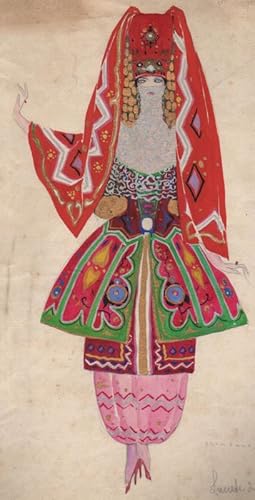
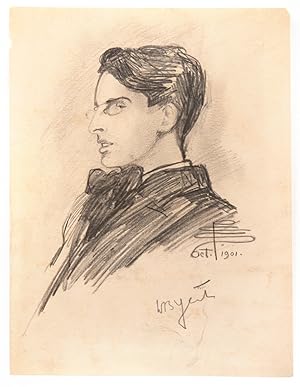
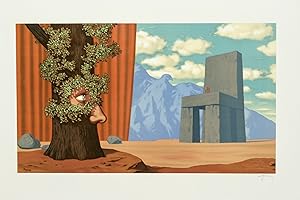
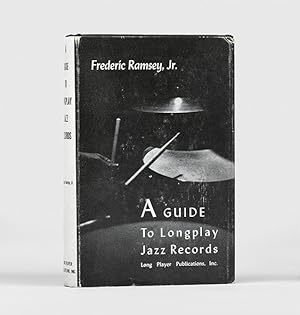

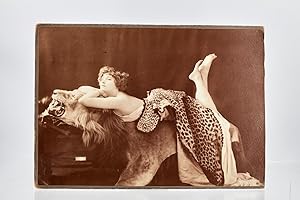
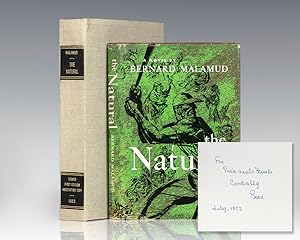
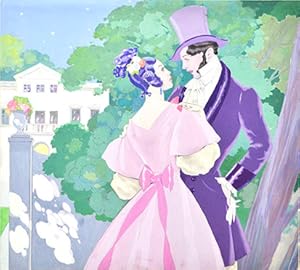
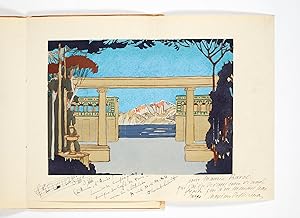
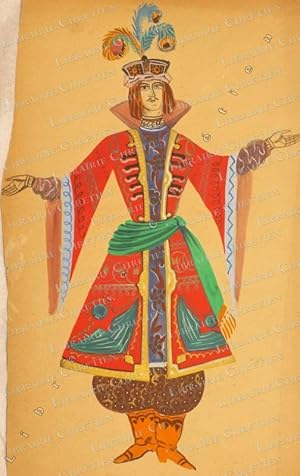

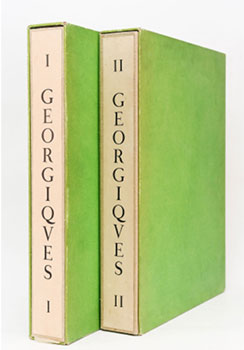
![Image du vendeur pour The Situationist Times. International Edition. Issues 1, 2, 3, 4, 5, 6 (6 volumes Complete) [Original Lithographs] mis en vente par ERIC CHAIM KLINE, BOOKSELLER (ABAA ILAB)](https://pictures.abebooks.com/inventory/md/md30983157551.jpg)
![Image du vendeur pour Dimanche : 27 Novembre 1960. Numéro Unique [aka : Yves Klein présente : le dimanche, 27 novembre 1960 : Festival d'art d'avant-garde, novembre-décembre 1960 : la révolution bleue continue : le journal d'un seul jour : numéro unique] [aka : Yves Klein Presents : Sunday, 27 November 1960. The Diary of a Single Day. The Blue Revolution Continues] mis en vente par Specific Object / David Platzker](https://pictures.abebooks.com/inventory/md/md31715320135.jpg)
